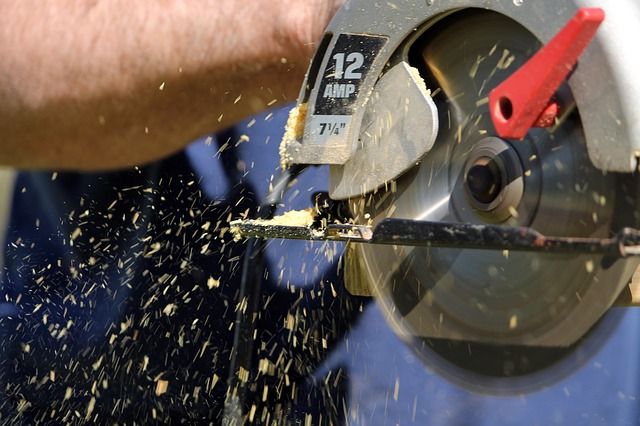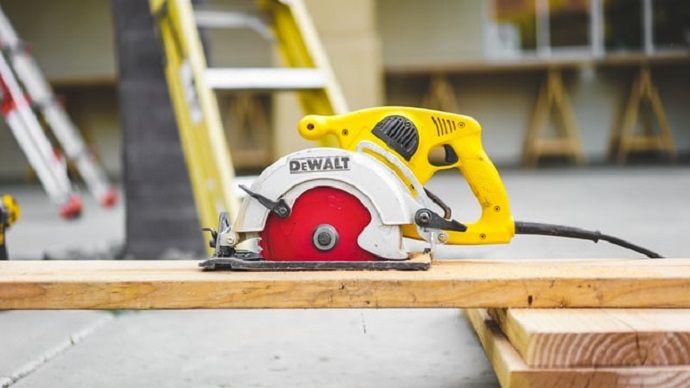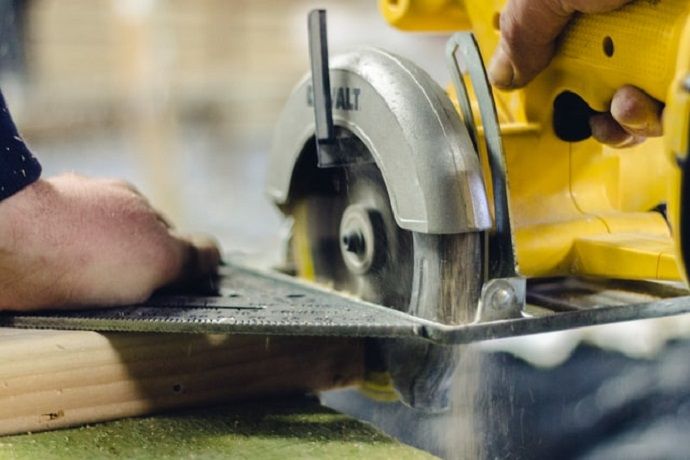Using a saw to solve minor home furnishing needs by yourself can be very convenient. You can save a lot of time and money this way. However, the task itself is not easy. You’ll be dealing with a sharp spinning blade, which can pose a major hazard.
Therefore, you need to know what you’re dealing with if you want solid results without jeopardizing your safety. You also need to understand just how deep your circular saw can cut to know if you’ll get the desired results. Our article will help you find out in just 3 easy steps.
Table of Contents
What Is a Circular Saw?

Circular saws are among the most commonly used saws at job sites and in woodworking areas. As the name implies, a circular saw contains a blade shaped like a circle with jaws protruding outwards. A blade guard covers the blade to protect against dust, dirt, and debris. Moreover, it also protects the user from material flyaways. Halfway down the blade is a footplate resting on the workpiece, keeping the work area stable.
In addition to being robust, it is also compact and lightweight, which makes it handy to use at job sites. Although it is portable, there is a limit to the types of cuts a circular saw offers. However, it has good precision, so the cuts are accurate, smooth, and neat.
What Are Its Uses?

It is a versatile tool capable of making accurate cuts in many materials. It is commonly used to cut concrete slabs, plywood, hardwood, and metal sheets. However, you will need a powerful and sharper blade for harder and rougher material. Therefore, depending on the material and the depth of cut you want, the type and size of the blade will vary. The following steps outline all there is to know about the circular saw’s cut capacity (or cutting depth).
Know the blade types
Since there isn’t one blade that does it all, you need to know the blades and their unique properties. Circular saw blades usually vary in size. Among the available sizes, a few regular sizes are standard and preferred by woodworkers for several day-to-day tasks. Then, there are special sizes used for specific types of cutting.
It is important to remember that you must always use highly sharp blades. Using a dull blade can damage the workpiece and result in an insufficient cut depth. Moreover, it can also be dangerous. Another point to consider is the safe distance. If the blade protrudes too much, it will be unstable, and this kickback limits the cut depth while also posing a hazard to the user.
Know what factors determine the depth of cut
The depth of the cut depends on two factors. Firstly, the size of the blade, and secondly, the cutting angle. The following table lists different sizes of blades and their cutting depth at 90 and 45 degrees.
| Saw Size (inches) | Cut Depth at 90° (inches) | Cut Depth 45° (inches) |
| 5.5 | ~1.75 | ~1.2 |
| 6.5 | ~2.04 | ~1.68 |
| 7.25 | ~2.5 | ~1.8 |
| 8.25 | ~2.8 | ~2.25 |
| 10.25 | ~3.68 | ~2.75 |
The most popular ones are the 6.5 and 7.5-inch blades, which can cut slightly over 2 inches. These blades can cut 2x2s in a single pass and 4x4s in two passes. On the other hand, using a razor-sharp blade of 10 inches, you can achieve a cut depth of 4 inches.
Generally, the larger the size of the blade, the greater the cut capacity. This is because the cut depth of a circular saw is equal to the blade’s radius minus the flange nut. Simply put, it is a little less than the blade’s radius. Hence, a larger blade has a greater radius. Thus, it will offer a deeper cut capacity as well. On the other hand, angling can decrease the cut capacity. A 90° angle provides maximum cut capacity, and a 45° bevel will limit the depth you can cut through.
Adjust cut depth
The depths of cuts mentioned above are the maximum cut sizes, meaning that you cannot cut deeper than the set limit. Still, you can use a large saw blade for more minor cuts.
The circular saw is easily adjustable via the footplate to get a cut depth of your choosing. First, unlock the footplate lever behind the blade guard, then lower or raise it to get the required blade depth. Once you are satisfied, make sure to lock the footplate in position. Besides the footplate movement, the bevel adjustment can also reduce the cut if needed. However, cutting at an angle is usually difficult compared to vertical cutting.
This adjustment feature of a circular saw will enable you to work on different material thicknesses (within the maximum cut capacity of the particular blade) without changing the blade every time.
However, while you can use larger blades for minor cuts, you should avoid this practice. A larger blade means you will have a harder time controlling the blade insertion. There is a high possibility that the actual cut will be deeper than the required depth.
We Think You’ll Like: How Many Watts Does a Circular Saw Use?
Key Details

Besides the basic mechanics of the circular saw, here are some helpful tips and tricks you can use to get a smooth and neat cut without damaging your saw or putting yourself at risk.
Do not insert the blade too deep
If you insert the blade too deep into the material, there is a possibility the saw will kick back and bind. Moreover, it is also hazardous because the sharp rotating blade protrudes from under the workpiece outside the worker’s vision.
Ensure proper blade depth
Firstly, retract the blade guard and hold the saw side by side with your workpiece. Secondly, check the blade depth so that it is not too deep, and then using the footplate lever, adjust the blade and lock it in position. Finally, manually compare the depth of the blade with that of the workpiece before locking it as a safety measure.
Allow free space for cutoff to fall
Allow enough space for the cutoff portion to fall. Restriction of the workpiece or job can affect the precision of the cut by blocking the reference line. However, near the completion of the cut, it is possible that the free part breaks off and damages the sample. To prevent this, loosely support the fallout without restricting it.
Add supports for cutting thin sheets
This is especially important for cutting plywood sheets. For instance, if there isn’t stable support throughout the length of the workpiece, the saw can bind, altering the cut depth and resulting in splinters and tearing.
We Think You’ll Like It: How to Cut PVC Pipe With Circular Saw
Frequently Asked Questions
Can we use bigger blades for a circular saw?
This depends on the size of your saw. You cannot mount a 6.5-inch blade on a 5.5-inch saw, and hence, the blade size must be smaller than the saw itself.
What is the exact cutting depth of a 10-inch circular saw?
The depth will vary based on the angle and the condition of the blade. A very sharp blade at 90° can cut up to 4-inches in a single pass. In general, you can make 3 to 3.5-inch cuts easily.
How do I set the depth of my circular saw?
Hold the blade parallel to the board by removing the blade guard. Adjust the blade level by raising or dropping the footplate lever to approximately 0.25-0.5 inches below the workpiece.
Can I use my circular saw as a table saw?
In theory, yes. However, the results will not be very efficient. It will require a lot of practice to handle a circular saw as a table saw.
What is a safe cutting depth?
This depends on the size of your blade and the depth of your workpiece. Make sure that the blade is not set too deep and that the pivot of the circular blade does not touch the workpiece.
Why can’t I make a cut of the required depth?
A major reason is improper depth setting. You must set the blade by comparing it to the actual depth of the workpiece. Additionally, low power can also be the reason. If the blade does not rotate at high speed, it can result in a shallow rough cut.
Final Words
By now, you must know the basic mechanics of a circular saw and the dos and don’ts to ensure a precise and crisp cut. The primary determinant of cut capacity is the blade size, saw the size, and cutting angle. Some minor factors that also contribute include the working condition of the saw and the blade.
Nonetheless, no matter how much information or experience you have, it is imperative that you wear the proper protective gear and pay heed to the general safety needs.
By following our guide, you can start your home project on any workpiece right away and get a clean, smooth cut without any splinter, all while ensuring the safety of the saw and yourself.